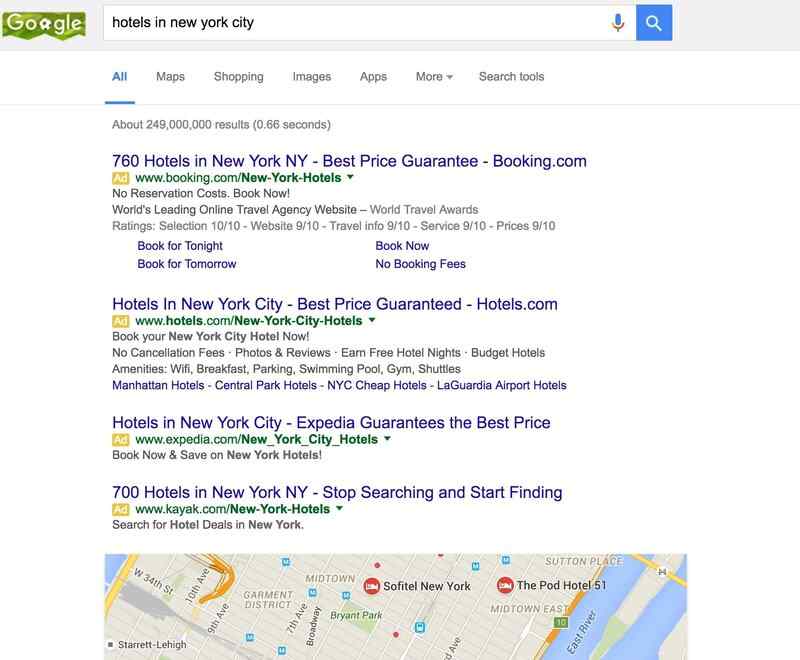Google User Interface Design Changes 2016
Did Google change their algorithm again?
In February 2016, Google removed right sidebar ads from SERPs and moved the paid search results to the top of the page. Now, up to four paid search results are allowed on a page. For some queries, this pushes nearly all the organic results down below the fold, potentially limiting the success of a brand’s SEO efforts.
It is important to note that although the number of ads allowed at the top of the SERP has increased, with the elimination of the right sidebar ads, there is still a net loss for the number of ad slots.
How will this change impact paid search and organic search?
Since there are fewer ad spots now appearing on SERPs, and the ones that are available are more expensive and highly-coveted, it is likely that the price of ads will rise. This can push some marketers out of the running, forcing them to move to less popular keywords or to shift their focus towards more organic search.
Since there are fewer organic spots appearing above the fold, the competition will also be fierce for the top organic slots. Brands will have to use all the tools at their disposal to maximize their visibility in the new Google user interface changes.
How to improve visibility with the new layout?
- Establish data tools that you can use to help identify important keywords and monitor your success. The intersection of data and content has become imperative to success. BrightEdge’s Data Cube will make it easy for you to secure the information you need.
- Build a list of keywords applicable to your industry and your ideal personas. Map the keywords to your buyer’s journey.
- Create content that fits the customer’s needs based upon this information.
- Use all available resources to optimize your content. This includes well-placed keywords, tags, optimized images, and schema markup. Schema can also help you take advantage of any available rich snippets to boost the appearance of your content in the SERPs.
- Distribute the content throughout your network to build traffic, engagement and backlinks.
- Monitor your success to see how your content is performing and ranking. Use the data to pinpoint the types of content and information that customers seem to respond to best.
When Google user interface design changes are made, it is easy to feel intimidated and overwhelmed by how the new layout might impact search. Focusing instead on creating content that fits the precise needs of your readers and optimizing that content will help your material get the attention it deserves.
<< Back to the SEO Glossary main page
Did Google change their algorithm again?
In February 2016, Google removed right sidebar ads from SERPs and moved the paid search results to the top of the page. Now, up to four paid search results are allowed on a page. For some queries, this pushes nearly all the organic results down below the fold, potentially limiting the success of a brand’s SEO efforts.
It is important to note that although the number of ads allowed at the top of the SERP has increased, with the elimination of the right sidebar ads, there is still a net loss for the number of ad slots.
How will this change impact paid search and organic search?
Since there are fewer ad spots now appearing on SERPs, and the ones that are available are more expensive and highly-coveted, it is likely that the price of ads will rise. This can push some marketers out of the running, forcing them to move to less popular keywords or to shift their focus towards more organic search.
Since there are fewer organic spots appearing above the fold, the competition will also be fierce for the top organic slots. Brands will have to use all the tools at their disposal to maximize their visibility in the new Google user interface changes.
How to improve visibility with the new layout?
- Establish data tools that you can use to help identify important keywords and monitor your success. The intersection of data and content has become imperative to success. BrightEdge’s Data Cube will make it easy for you to secure the information you need.
- Build a list of keywords applicable to your industry and your ideal personas. Map the keywords to your buyer’s journey.
- Create content that fits the customer’s needs based upon this information.
- Use all available resources to optimize your content. This includes well-placed keywords, tags, optimized images, and schema markup. Schema can also help you take advantage of any available rich snippets to boost the appearance of your content in the SERPs.
- Distribute the content throughout your network to build traffic, engagement and backlinks.
- Monitor your success to see how your content is performing and ranking. Use the data to pinpoint the types of content and information that customers seem to respond to best.
When Google user interface design changes are made, it is easy to feel intimidated and overwhelmed by how the new layout might impact search. Focusing instead on creating content that fits the precise needs of your readers and optimizing that content will help your material get the attention it deserves.

